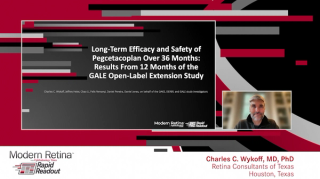
Geographic Atrophy
Latest News
Latest Videos

More News


The newest research findings create "tangible benchmarks" for how earlier treatment can lead to better outcomes, said Dr. Kim.

Maximizing treatment based on GA location, lesion progression, and morphologic retinal changes.

David R. Lally, MD, discusses promising results from the ARCHER trial on ANX007 for age-related macular degeneration, emphasizing the need for vision-preserving treatments.

The company can now initiate the Opti-GAIN (Optimized Geographic Atrophy INterventional) phase 1/2 clinical trial.

Patient response focused on perceived vision-related quality of life outcomes, investigators said.

Character Biosciences enhances its leadership team and secures $93 million in Series B funding to advance treatments for degenerative eye diseases.

The lesion area growth was reduced by more than 50% in the first human clinical trial of K8.

Belite Bio completes its phase 3 trial for tinlarebant, a potential first treatment for Stargardt disease, with results expected in late 2025.

Researchers conducted this study to determine how often and why spontaneous soft drusen regresses without atrophy in patients who had intermediate or atrophic age-related macular degeneration.

Researchers will investigate a gene in the eye that is crucial for normal vision, but can cause retinal diseases when mutated that often lead to blindness.

Recent research highlights inferred sensitivity mapping as a promising method to assess retinal function in geographic atrophy, enhancing clinical trial outcomes.

A study reveals that ophthalmic artery angioplasty improves vision and functionality in patients with late-stage age-related macular degeneration.

An understanding of GA growth kinetics is key to addressing the pathophysiology of age-related macular degeneration.


Fovea-sparing, multifocal, and bilateral lesions exhibited the fastest growth rates.

Kriya is developing gene therapies targeting chronic diseases such as geographic atrophy, trigeminal neuralgia, and type 1 diabetes.

A look at podium presentations on GA research at ASRS 2025.

Catch up on recent advancements in retina care, including new therapies for age-related macular degeneration and macular telangiectasia, enhancing patient outcomes.





Vonaprument has received fast track designation from the US Food and Drug Administration.

Sanofi's SAR446597 receives FDA fast track designation, offering a promising one-time gene therapy for geographic atrophy and reducing treatment frequency.











